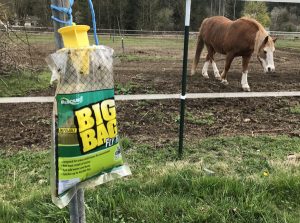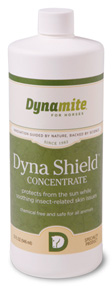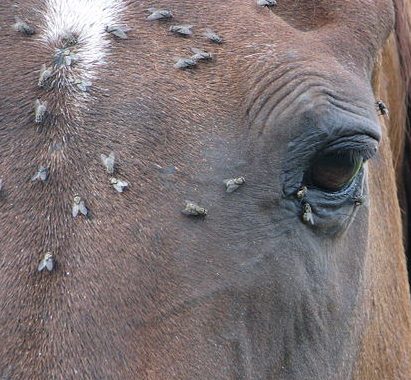The mild weather and rains of spring are a welcome sign that winter has ended, but unfortunately it is the ideal time for flying insect breeding. This time of year, many stables are starting to get hit by flies, but action taken now, using an integrated pest management (IPM) approach, can avoid a crisis situation later.
IPM is a more environmentally sensitive pest management strategy that balances prevention and facility maintenance with limited use of pesticides for “targeted strikes”. By using IPM techniques, stable owners can protect their horses from mosquito-born diseases and the stress of uncontrolled fly populations; but they need to get started now. Here are a number of things you can use as part of an integrated pest management program and stay ahead of the flies and mosquitoes this year.
Reduce reproduction:
Know your enemy. There are thousands of fly species in North America, but only a few bother horses. Knowing which ones are your enemy will help you understand their habits and know what strategies will be most effective. Look to your Extension agent or integrated pest management practitioner to help you identify the problem critters. They can set a variety of traps that will help you determine the extent of the problem and help you measure your fly program’s success.
Look for the source. Flies and mosquitoes lay hundreds of eggs every few days. Your fly control program can be much more effective if you first eliminate the breeding sources and break the lifecycle. Mosquitoes lay there eggs in or near still water, while black flies prefer clean, flowing water. Stable flies and houseflies prefer to breed in moist, organic matter, like horse manure or urine-soaked bedding, while horn and face flies prefer cow manure. Horse, and deer flies like wetlands vegetation.
 Stay on top of waste removal. Clean stalls, paddocks, pens, pastures, etc. at least once, if not twice, per day. Keep manure and composting piles away from areas where horses will congregate. This allows you to reduce the access to bothersome flies and selectively treat problem areas, if necessary, without impacting your horses.
Stay on top of waste removal. Clean stalls, paddocks, pens, pastures, etc. at least once, if not twice, per day. Keep manure and composting piles away from areas where horses will congregate. This allows you to reduce the access to bothersome flies and selectively treat problem areas, if necessary, without impacting your horses.
Spread manure selectively. If you spread your waste, avoid doing it in pastures that will be used during fly season and disk it under if you spread it on crop fields. Also avoid spreading it in high traffic areas like along fence lines where it can mix with mud and stay wet. If you cannot easily remove manure dropped by horses in the pasture, be sure to at least break it up so it dries quickly.
Eliminate standing water. During the rains of spring and summer, there are scores of places that rain water can congregate and stand. These make great breeding grounds for mosquitoes. After a storm, look to see where water builds up, and clean, fill in or eliminate those areas. Common problem areas include clogged rain gutters, old tires, buckets, birdbaths and pot holes. Mosquito eggs can hatch in a matter of hours or lie dormant for long periods during dry conditions, so any area that holds water can be a potential breeding ground.
Cut brush and tall grasses. Many biting flies breed and rest in vegetation. Keep areas near your horse trimmed and mowed.
Control larvae and pupae:
Keep drinking water fresh. Water troughs can be great mosquito breeding grounds. Be sure to change out the water regularly and especially if you see “wigglers,” the larval stage of mosquitoes. Also drain and keep dry the ground around the trough.
Maintain ponds and streams. It is pretty tough to keep insects from breeding in natural water bodies, but there are some things you can do to reduce the impact. Start by clearing floating debris. If the pond can sustain fish, consider stocking it with minnows or other small fish that eat mosquito larvae. For stagnant pools, work with your IPM technician to verify the presence of larvae and apply a “larvicide” in precise amounts.
Introduce natural fly parasites. Nematodes, microscopic roundworms that live in the soil, can be effective against the larvae of house flies and stable flies. Species such as Steinernema carpocapsae are shipped dormant mixed with water, and spread on manure piles and breeding areas.
Pupated flies can be controlled with tiny wasps known as Spagalangia nigroaena or Muscidifurax raptor that sting fly pupae and lay their eggs inside. When the wasp larvae hatch, they eat the contents inside. These wasps, which are only about an eighth of an inch long, need to be applied every few weeks.
Attack the adults:
Encourage bats and birds. Make your stable a welcoming place for natural fly and mosquito predators. Songbirds like swallows, chickadees, jays, fly catchers and wrens love an insect feast. Barn swallows and purple martins are two of the most prolific fly eaters. You can encourage them by providing food, shelter and fresh water.
Bats are also prolific insect eaters. They can catch as many as 2,000 flying insects in one night. Erect a commercial or homemade bat house to keep them out of the barn, but nearby.
Treat problem areas. It is best to eliminate flying insects as early in the lifecycle as possible. Unfortunately, severe infestations caused by wet or flooded conditions, or off-site, uncontrollable breeding areas will require the application of “adulticides.” Professional application techniques assure that the adulticide is applied in precise amounts that do not result in run-off. Unlike home garden sprayers, the droplets stay where they are sprayed. Microencapsulated products that pass through the digestive system can be applied in areas where peripheral grazing may occur.
 Set traps. Fly tape, flyer catchers and bug zappers can attract and kill adult flies. There is a wide selection of trap types and techniques, some work better than others. If you are not sure what works best, ask for advice. Be aware, bug zappers have limited use against mosquitoes. Mosquitoes are attracted by carbon dioxide and heat. Also be sure to place zappers away from animals, otherwise you will be attracting bugs to them.
Set traps. Fly tape, flyer catchers and bug zappers can attract and kill adult flies. There is a wide selection of trap types and techniques, some work better than others. If you are not sure what works best, ask for advice. Be aware, bug zappers have limited use against mosquitoes. Mosquitoes are attracted by carbon dioxide and heat. Also be sure to place zappers away from animals, otherwise you will be attracting bugs to them.
Protect your horse:
Separate livestock. If you have both horses and cows or live near a cattle operation, try to keep them separated by one quarter mile or more. Horn flies and face flies bother both, but prefer to breed in cow manure.
Add screens. Consider adding screens to your stable. They will discourage insects from entering while at the same time keep air circulating.
Keep the air flowing. As mentioned earlier, mosquitoes are attracted by heat and carbon dioxide. Add fans at either end of the barn to reduce the build-up of attractive gases and smells.
Use non-attractive lights. Limit your use of lights at night and replace bright, white bulbs with yellow or sodium-vapor lights.
Use repellants. There are scores of commercial and homemade equine insect repellants available. Although they are short-lived in effectiveness, daily applications can help reduce bothersome insects.
 If you use these, avoid anything with harsh chemicals or pesticides. Here at NWNHC we rely on all-natural Dyna Shield to repel flies on the horses and revitalize their coats.
If you use these, avoid anything with harsh chemicals or pesticides. Here at NWNHC we rely on all-natural Dyna Shield to repel flies on the horses and revitalize their coats.
Garlic can also be added to feed at a dose of a tablespoon or two per day. Many horseman believe that the strong oils in garlic, that are excreted through the skin, repel insects.
Get everyone on board. Developing and maintaining an integrated pest management program can be time consuming and complicated. Make sure that other horse owners in your barn understand the program and follow through with their part.
Jim “Hutch” Hutchins owns and manages NWNHC, a natural horsemanship education center in Fall City, Wash. (just East of Seattle). To contact Hutch write to nwnhc@nwnhc.com. For all-natural fly repellent visit the NWHC Store at: http://shop.nwnhc.com
Did You Know?
- One housefly can be the progenitor of a sextillion flies in one season.
- Mosquitoes are attracted by carbon dioxide and heat.
- Bats can eat almost 2,000 flying insects per night.
- Male mosquitoes eat nectar, not blood.
- Light-colored fly sheets deter horseflies that are attracted to dark colors.
- The most effective way to reduce flies and mosquitoes is to reduce their breeding sites.
